System Analysis: NewAccess Mental Health System Development
VerifiedAdded on 2023/06/12
|12
|2606
|420
Report
AI Summary
This report provides a comprehensive system analysis of the NewAccess mental health intervention system, designed to capture and share patient stories securely among healthcare professionals. It identifies key non-functional requirements such as functionality, usability, reliability, performance, and security, emphasizing data encryption and access control. The report reviews the hybrid cloud approach chosen for data storage, highlighting its advantages in data security and accessibility, while also acknowledging its complexities and costs. Furthermore, it compares predictive and adaptive SDLC approaches, recommending the predictive SDLC for its clear deliverables and cost-effectiveness. The analysis aims to optimize the system's implementation, ensuring efficient and secure data management to improve mental healthcare delivery. Desklib offers this assignment and many more to aid students in their studies.

Running head: SYSTEM ANALYSIS
System Analysis
Name of the Student
Name of the University
Author Note
System Analysis
Name of the Student
Name of the University
Author Note
Paraphrase This Document
Need a fresh take? Get an instant paraphrase of this document with our AI Paraphraser
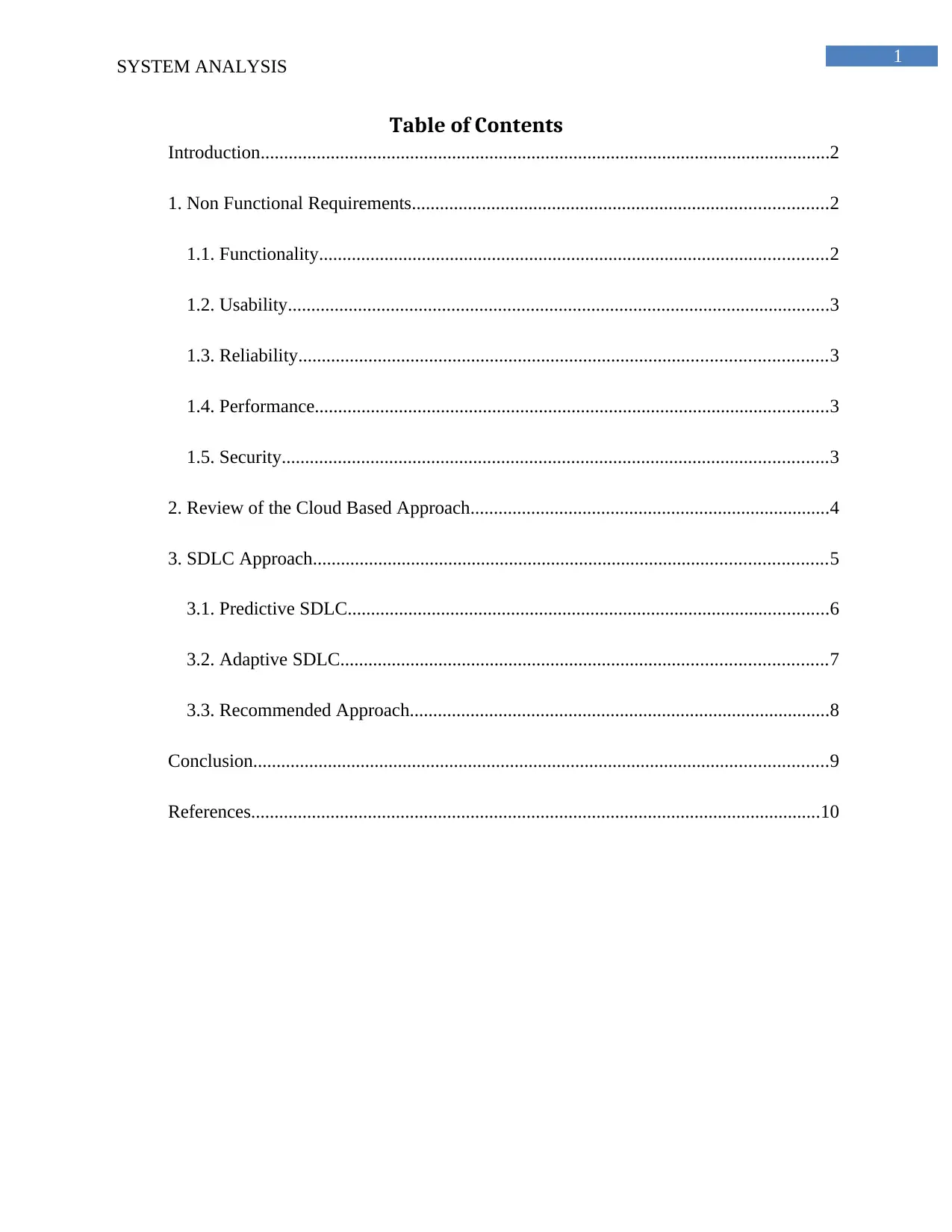
1
SYSTEM ANALYSIS
Table of Contents
Introduction..........................................................................................................................2
1. Non Functional Requirements.........................................................................................2
1.1. Functionality.............................................................................................................2
1.2. Usability....................................................................................................................3
1.3. Reliability.................................................................................................................3
1.4. Performance..............................................................................................................3
1.5. Security.....................................................................................................................3
2. Review of the Cloud Based Approach.............................................................................4
3. SDLC Approach..............................................................................................................5
3.1. Predictive SDLC.......................................................................................................6
3.2. Adaptive SDLC........................................................................................................7
3.3. Recommended Approach..........................................................................................8
Conclusion...........................................................................................................................9
References..........................................................................................................................10
SYSTEM ANALYSIS
Table of Contents
Introduction..........................................................................................................................2
1. Non Functional Requirements.........................................................................................2
1.1. Functionality.............................................................................................................2
1.2. Usability....................................................................................................................3
1.3. Reliability.................................................................................................................3
1.4. Performance..............................................................................................................3
1.5. Security.....................................................................................................................3
2. Review of the Cloud Based Approach.............................................................................4
3. SDLC Approach..............................................................................................................5
3.1. Predictive SDLC.......................................................................................................6
3.2. Adaptive SDLC........................................................................................................7
3.3. Recommended Approach..........................................................................................8
Conclusion...........................................................................................................................9
References..........................................................................................................................10
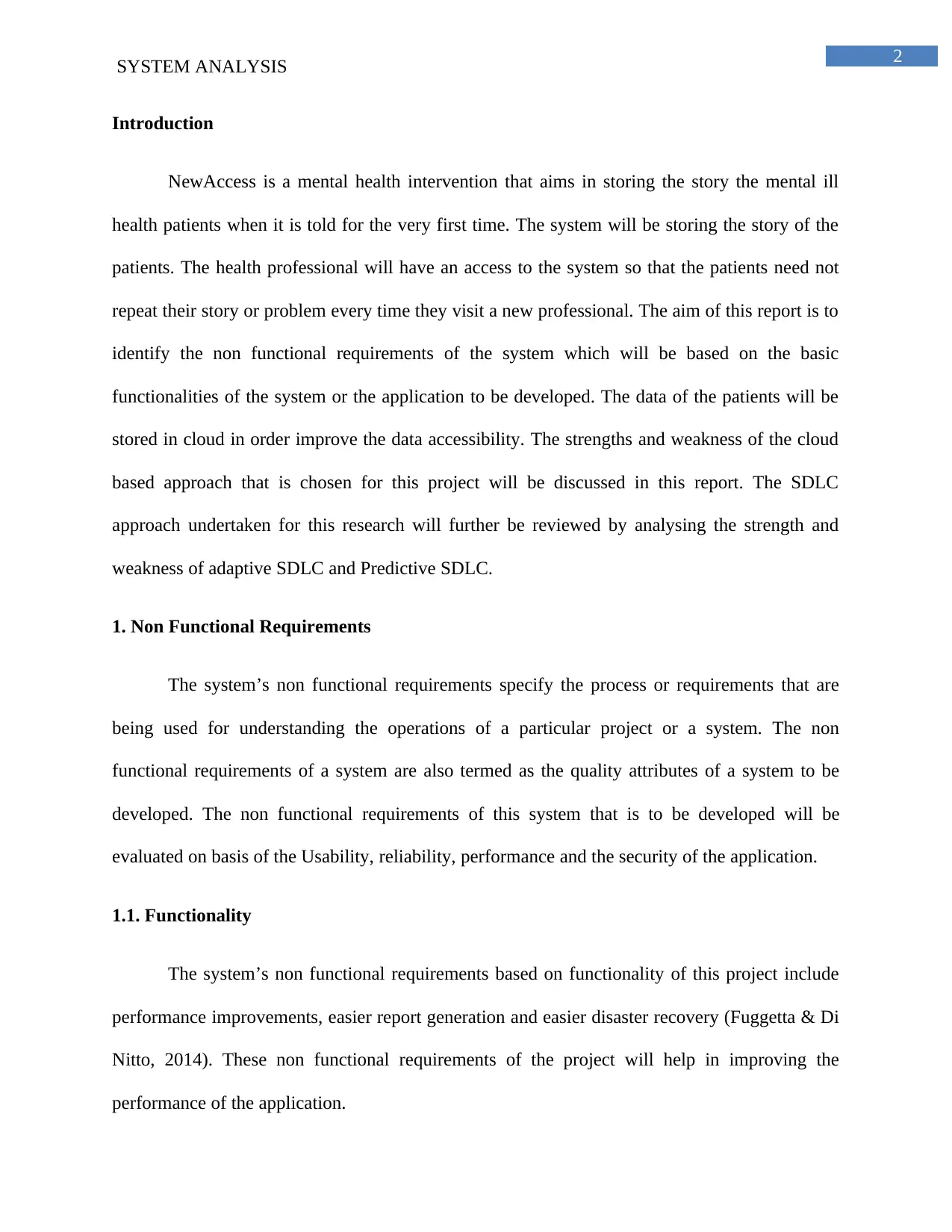
2
SYSTEM ANALYSIS
Introduction
NewAccess is a mental health intervention that aims in storing the story the mental ill
health patients when it is told for the very first time. The system will be storing the story of the
patients. The health professional will have an access to the system so that the patients need not
repeat their story or problem every time they visit a new professional. The aim of this report is to
identify the non functional requirements of the system which will be based on the basic
functionalities of the system or the application to be developed. The data of the patients will be
stored in cloud in order improve the data accessibility. The strengths and weakness of the cloud
based approach that is chosen for this project will be discussed in this report. The SDLC
approach undertaken for this research will further be reviewed by analysing the strength and
weakness of adaptive SDLC and Predictive SDLC.
1. Non Functional Requirements
The system’s non functional requirements specify the process or requirements that are
being used for understanding the operations of a particular project or a system. The non
functional requirements of a system are also termed as the quality attributes of a system to be
developed. The non functional requirements of this system that is to be developed will be
evaluated on basis of the Usability, reliability, performance and the security of the application.
1.1. Functionality
The system’s non functional requirements based on functionality of this project include
performance improvements, easier report generation and easier disaster recovery (Fuggetta & Di
Nitto, 2014). These non functional requirements of the project will help in improving the
performance of the application.
SYSTEM ANALYSIS
Introduction
NewAccess is a mental health intervention that aims in storing the story the mental ill
health patients when it is told for the very first time. The system will be storing the story of the
patients. The health professional will have an access to the system so that the patients need not
repeat their story or problem every time they visit a new professional. The aim of this report is to
identify the non functional requirements of the system which will be based on the basic
functionalities of the system or the application to be developed. The data of the patients will be
stored in cloud in order improve the data accessibility. The strengths and weakness of the cloud
based approach that is chosen for this project will be discussed in this report. The SDLC
approach undertaken for this research will further be reviewed by analysing the strength and
weakness of adaptive SDLC and Predictive SDLC.
1. Non Functional Requirements
The system’s non functional requirements specify the process or requirements that are
being used for understanding the operations of a particular project or a system. The non
functional requirements of a system are also termed as the quality attributes of a system to be
developed. The non functional requirements of this system that is to be developed will be
evaluated on basis of the Usability, reliability, performance and the security of the application.
1.1. Functionality
The system’s non functional requirements based on functionality of this project include
performance improvements, easier report generation and easier disaster recovery (Fuggetta & Di
Nitto, 2014). These non functional requirements of the project will help in improving the
performance of the application.
⊘ This is a preview!⊘
Do you want full access?
Subscribe today to unlock all pages.

Trusted by 1+ million students worldwide
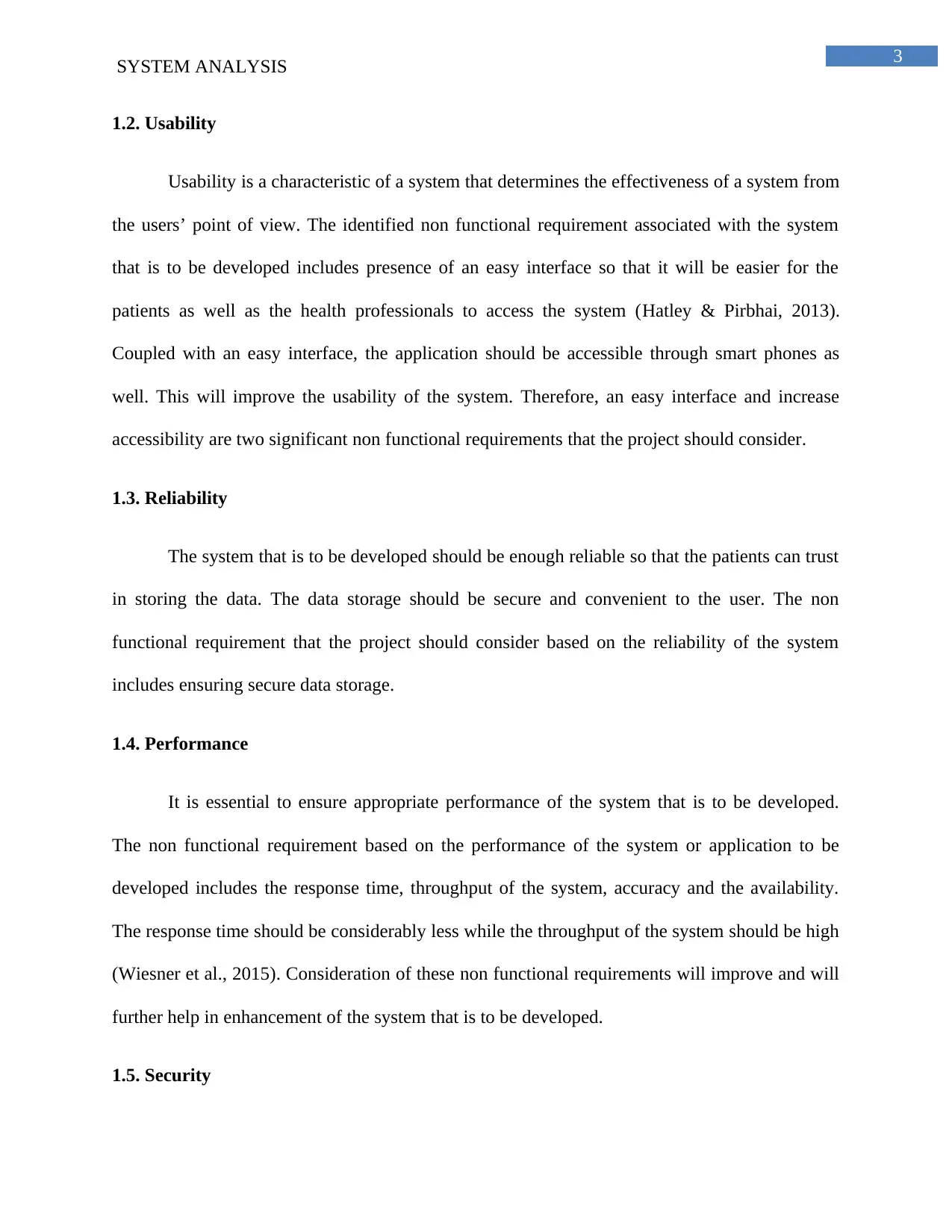
3
SYSTEM ANALYSIS
1.2. Usability
Usability is a characteristic of a system that determines the effectiveness of a system from
the users’ point of view. The identified non functional requirement associated with the system
that is to be developed includes presence of an easy interface so that it will be easier for the
patients as well as the health professionals to access the system (Hatley & Pirbhai, 2013).
Coupled with an easy interface, the application should be accessible through smart phones as
well. This will improve the usability of the system. Therefore, an easy interface and increase
accessibility are two significant non functional requirements that the project should consider.
1.3. Reliability
The system that is to be developed should be enough reliable so that the patients can trust
in storing the data. The data storage should be secure and convenient to the user. The non
functional requirement that the project should consider based on the reliability of the system
includes ensuring secure data storage.
1.4. Performance
It is essential to ensure appropriate performance of the system that is to be developed.
The non functional requirement based on the performance of the system or application to be
developed includes the response time, throughput of the system, accuracy and the availability.
The response time should be considerably less while the throughput of the system should be high
(Wiesner et al., 2015). Consideration of these non functional requirements will improve and will
further help in enhancement of the system that is to be developed.
1.5. Security
SYSTEM ANALYSIS
1.2. Usability
Usability is a characteristic of a system that determines the effectiveness of a system from
the users’ point of view. The identified non functional requirement associated with the system
that is to be developed includes presence of an easy interface so that it will be easier for the
patients as well as the health professionals to access the system (Hatley & Pirbhai, 2013).
Coupled with an easy interface, the application should be accessible through smart phones as
well. This will improve the usability of the system. Therefore, an easy interface and increase
accessibility are two significant non functional requirements that the project should consider.
1.3. Reliability
The system that is to be developed should be enough reliable so that the patients can trust
in storing the data. The data storage should be secure and convenient to the user. The non
functional requirement that the project should consider based on the reliability of the system
includes ensuring secure data storage.
1.4. Performance
It is essential to ensure appropriate performance of the system that is to be developed.
The non functional requirement based on the performance of the system or application to be
developed includes the response time, throughput of the system, accuracy and the availability.
The response time should be considerably less while the throughput of the system should be high
(Wiesner et al., 2015). Consideration of these non functional requirements will improve and will
further help in enhancement of the system that is to be developed.
1.5. Security
Paraphrase This Document
Need a fresh take? Get an instant paraphrase of this document with our AI Paraphraser
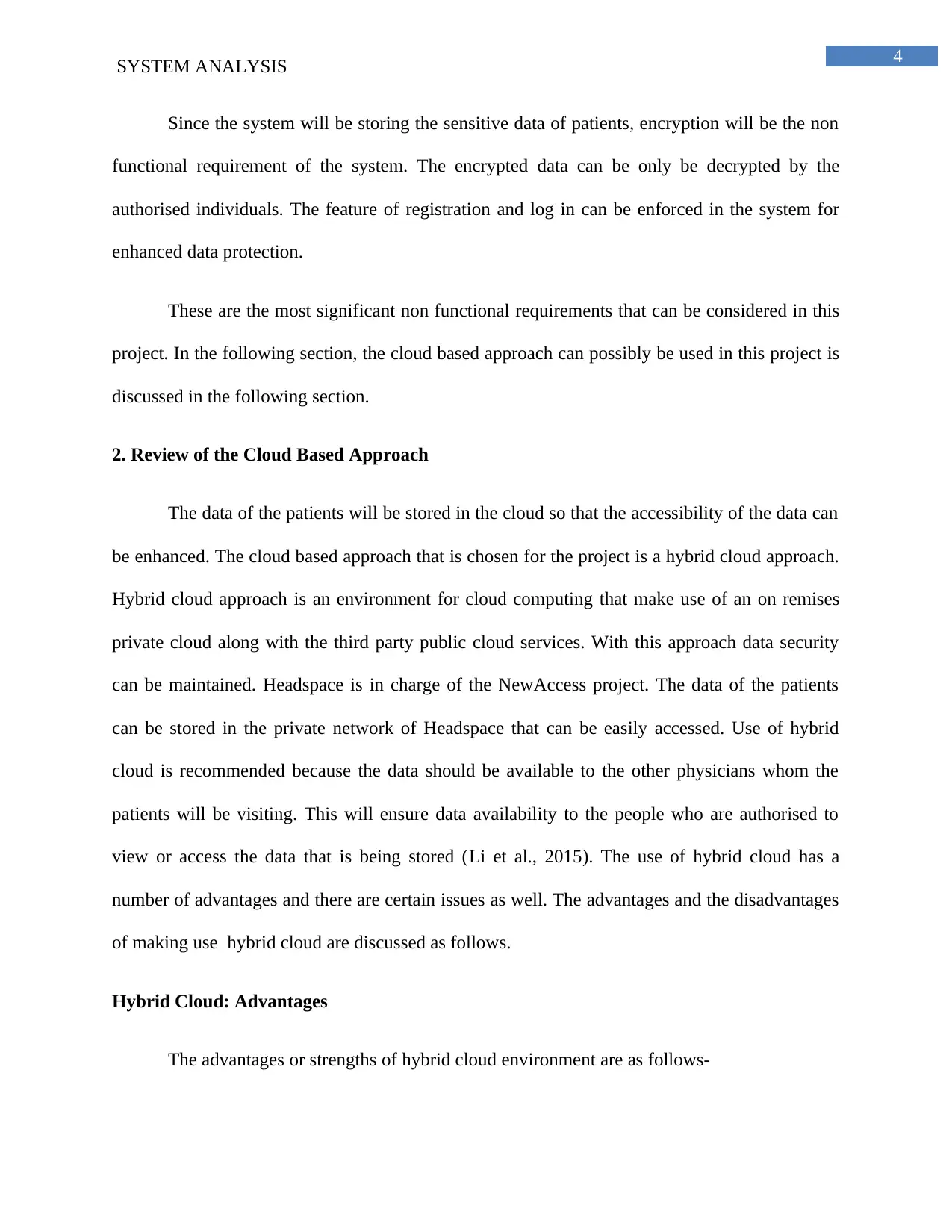
4
SYSTEM ANALYSIS
Since the system will be storing the sensitive data of patients, encryption will be the non
functional requirement of the system. The encrypted data can be only be decrypted by the
authorised individuals. The feature of registration and log in can be enforced in the system for
enhanced data protection.
These are the most significant non functional requirements that can be considered in this
project. In the following section, the cloud based approach can possibly be used in this project is
discussed in the following section.
2. Review of the Cloud Based Approach
The data of the patients will be stored in the cloud so that the accessibility of the data can
be enhanced. The cloud based approach that is chosen for the project is a hybrid cloud approach.
Hybrid cloud approach is an environment for cloud computing that make use of an on remises
private cloud along with the third party public cloud services. With this approach data security
can be maintained. Headspace is in charge of the NewAccess project. The data of the patients
can be stored in the private network of Headspace that can be easily accessed. Use of hybrid
cloud is recommended because the data should be available to the other physicians whom the
patients will be visiting. This will ensure data availability to the people who are authorised to
view or access the data that is being stored (Li et al., 2015). The use of hybrid cloud has a
number of advantages and there are certain issues as well. The advantages and the disadvantages
of making use hybrid cloud are discussed as follows.
Hybrid Cloud: Advantages
The advantages or strengths of hybrid cloud environment are as follows-
SYSTEM ANALYSIS
Since the system will be storing the sensitive data of patients, encryption will be the non
functional requirement of the system. The encrypted data can be only be decrypted by the
authorised individuals. The feature of registration and log in can be enforced in the system for
enhanced data protection.
These are the most significant non functional requirements that can be considered in this
project. In the following section, the cloud based approach can possibly be used in this project is
discussed in the following section.
2. Review of the Cloud Based Approach
The data of the patients will be stored in the cloud so that the accessibility of the data can
be enhanced. The cloud based approach that is chosen for the project is a hybrid cloud approach.
Hybrid cloud approach is an environment for cloud computing that make use of an on remises
private cloud along with the third party public cloud services. With this approach data security
can be maintained. Headspace is in charge of the NewAccess project. The data of the patients
can be stored in the private network of Headspace that can be easily accessed. Use of hybrid
cloud is recommended because the data should be available to the other physicians whom the
patients will be visiting. This will ensure data availability to the people who are authorised to
view or access the data that is being stored (Li et al., 2015). The use of hybrid cloud has a
number of advantages and there are certain issues as well. The advantages and the disadvantages
of making use hybrid cloud are discussed as follows.
Hybrid Cloud: Advantages
The advantages or strengths of hybrid cloud environment are as follows-
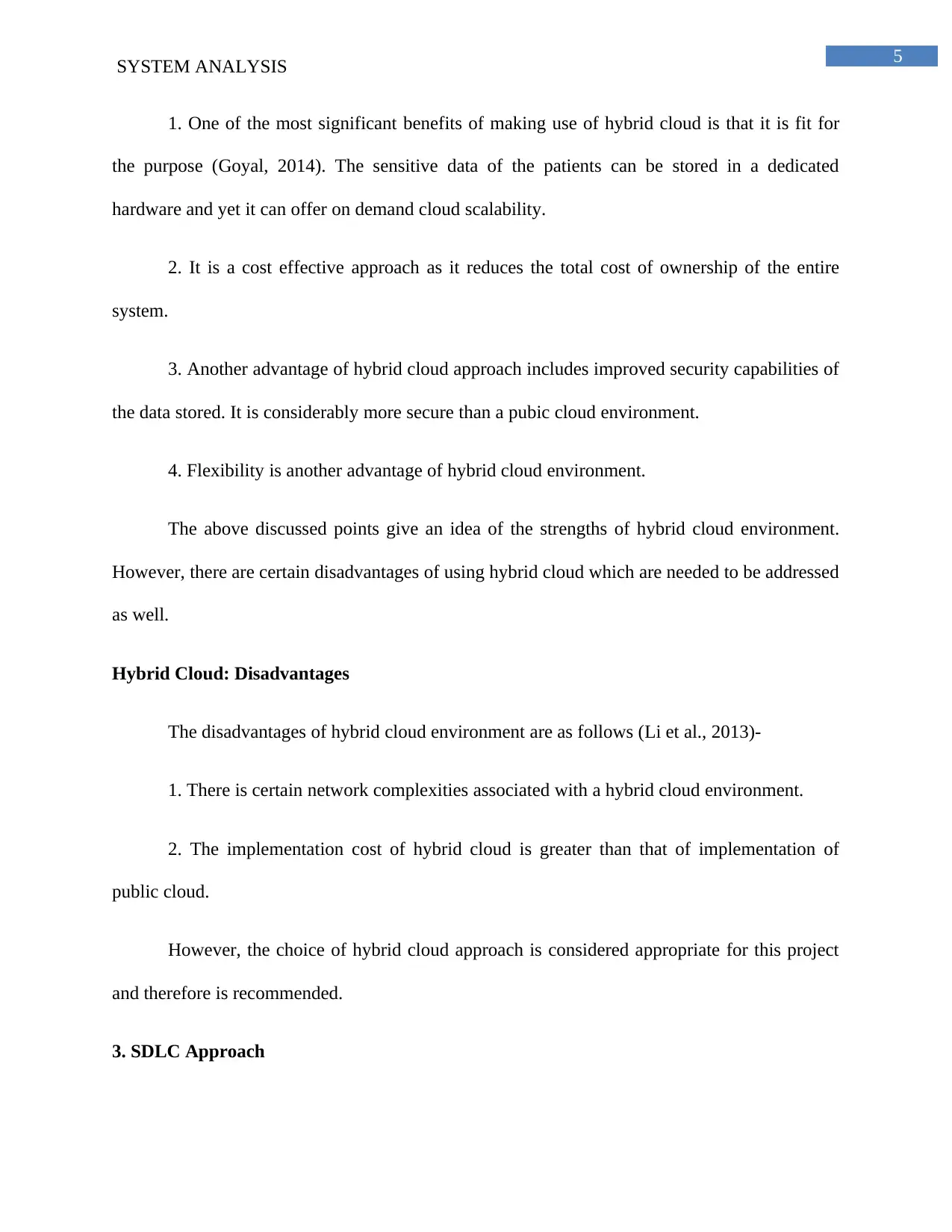
5
SYSTEM ANALYSIS
1. One of the most significant benefits of making use of hybrid cloud is that it is fit for
the purpose (Goyal, 2014). The sensitive data of the patients can be stored in a dedicated
hardware and yet it can offer on demand cloud scalability.
2. It is a cost effective approach as it reduces the total cost of ownership of the entire
system.
3. Another advantage of hybrid cloud approach includes improved security capabilities of
the data stored. It is considerably more secure than a pubic cloud environment.
4. Flexibility is another advantage of hybrid cloud environment.
The above discussed points give an idea of the strengths of hybrid cloud environment.
However, there are certain disadvantages of using hybrid cloud which are needed to be addressed
as well.
Hybrid Cloud: Disadvantages
The disadvantages of hybrid cloud environment are as follows (Li et al., 2013)-
1. There is certain network complexities associated with a hybrid cloud environment.
2. The implementation cost of hybrid cloud is greater than that of implementation of
public cloud.
However, the choice of hybrid cloud approach is considered appropriate for this project
and therefore is recommended.
3. SDLC Approach
SYSTEM ANALYSIS
1. One of the most significant benefits of making use of hybrid cloud is that it is fit for
the purpose (Goyal, 2014). The sensitive data of the patients can be stored in a dedicated
hardware and yet it can offer on demand cloud scalability.
2. It is a cost effective approach as it reduces the total cost of ownership of the entire
system.
3. Another advantage of hybrid cloud approach includes improved security capabilities of
the data stored. It is considerably more secure than a pubic cloud environment.
4. Flexibility is another advantage of hybrid cloud environment.
The above discussed points give an idea of the strengths of hybrid cloud environment.
However, there are certain disadvantages of using hybrid cloud which are needed to be addressed
as well.
Hybrid Cloud: Disadvantages
The disadvantages of hybrid cloud environment are as follows (Li et al., 2013)-
1. There is certain network complexities associated with a hybrid cloud environment.
2. The implementation cost of hybrid cloud is greater than that of implementation of
public cloud.
However, the choice of hybrid cloud approach is considered appropriate for this project
and therefore is recommended.
3. SDLC Approach
⊘ This is a preview!⊘
Do you want full access?
Subscribe today to unlock all pages.

Trusted by 1+ million students worldwide
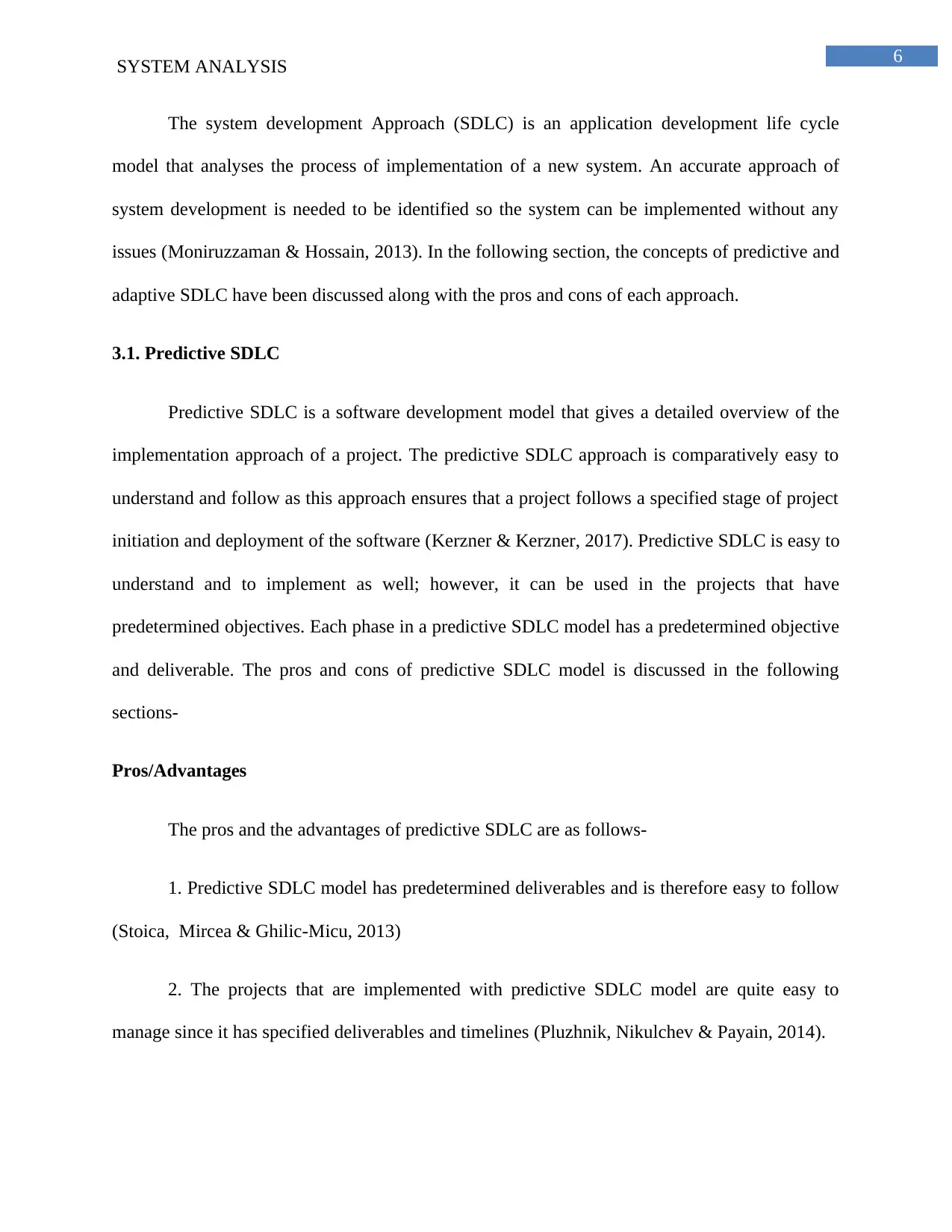
6
SYSTEM ANALYSIS
The system development Approach (SDLC) is an application development life cycle
model that analyses the process of implementation of a new system. An accurate approach of
system development is needed to be identified so the system can be implemented without any
issues (Moniruzzaman & Hossain, 2013). In the following section, the concepts of predictive and
adaptive SDLC have been discussed along with the pros and cons of each approach.
3.1. Predictive SDLC
Predictive SDLC is a software development model that gives a detailed overview of the
implementation approach of a project. The predictive SDLC approach is comparatively easy to
understand and follow as this approach ensures that a project follows a specified stage of project
initiation and deployment of the software (Kerzner & Kerzner, 2017). Predictive SDLC is easy to
understand and to implement as well; however, it can be used in the projects that have
predetermined objectives. Each phase in a predictive SDLC model has a predetermined objective
and deliverable. The pros and cons of predictive SDLC model is discussed in the following
sections-
Pros/Advantages
The pros and the advantages of predictive SDLC are as follows-
1. Predictive SDLC model has predetermined deliverables and is therefore easy to follow
(Stoica, Mircea & Ghilic-Micu, 2013)
2. The projects that are implemented with predictive SDLC model are quite easy to
manage since it has specified deliverables and timelines (Pluzhnik, Nikulchev & Payain, 2014).
SYSTEM ANALYSIS
The system development Approach (SDLC) is an application development life cycle
model that analyses the process of implementation of a new system. An accurate approach of
system development is needed to be identified so the system can be implemented without any
issues (Moniruzzaman & Hossain, 2013). In the following section, the concepts of predictive and
adaptive SDLC have been discussed along with the pros and cons of each approach.
3.1. Predictive SDLC
Predictive SDLC is a software development model that gives a detailed overview of the
implementation approach of a project. The predictive SDLC approach is comparatively easy to
understand and follow as this approach ensures that a project follows a specified stage of project
initiation and deployment of the software (Kerzner & Kerzner, 2017). Predictive SDLC is easy to
understand and to implement as well; however, it can be used in the projects that have
predetermined objectives. Each phase in a predictive SDLC model has a predetermined objective
and deliverable. The pros and cons of predictive SDLC model is discussed in the following
sections-
Pros/Advantages
The pros and the advantages of predictive SDLC are as follows-
1. Predictive SDLC model has predetermined deliverables and is therefore easy to follow
(Stoica, Mircea & Ghilic-Micu, 2013)
2. The projects that are implemented with predictive SDLC model are quite easy to
manage since it has specified deliverables and timelines (Pluzhnik, Nikulchev & Payain, 2014).
Paraphrase This Document
Need a fresh take? Get an instant paraphrase of this document with our AI Paraphraser
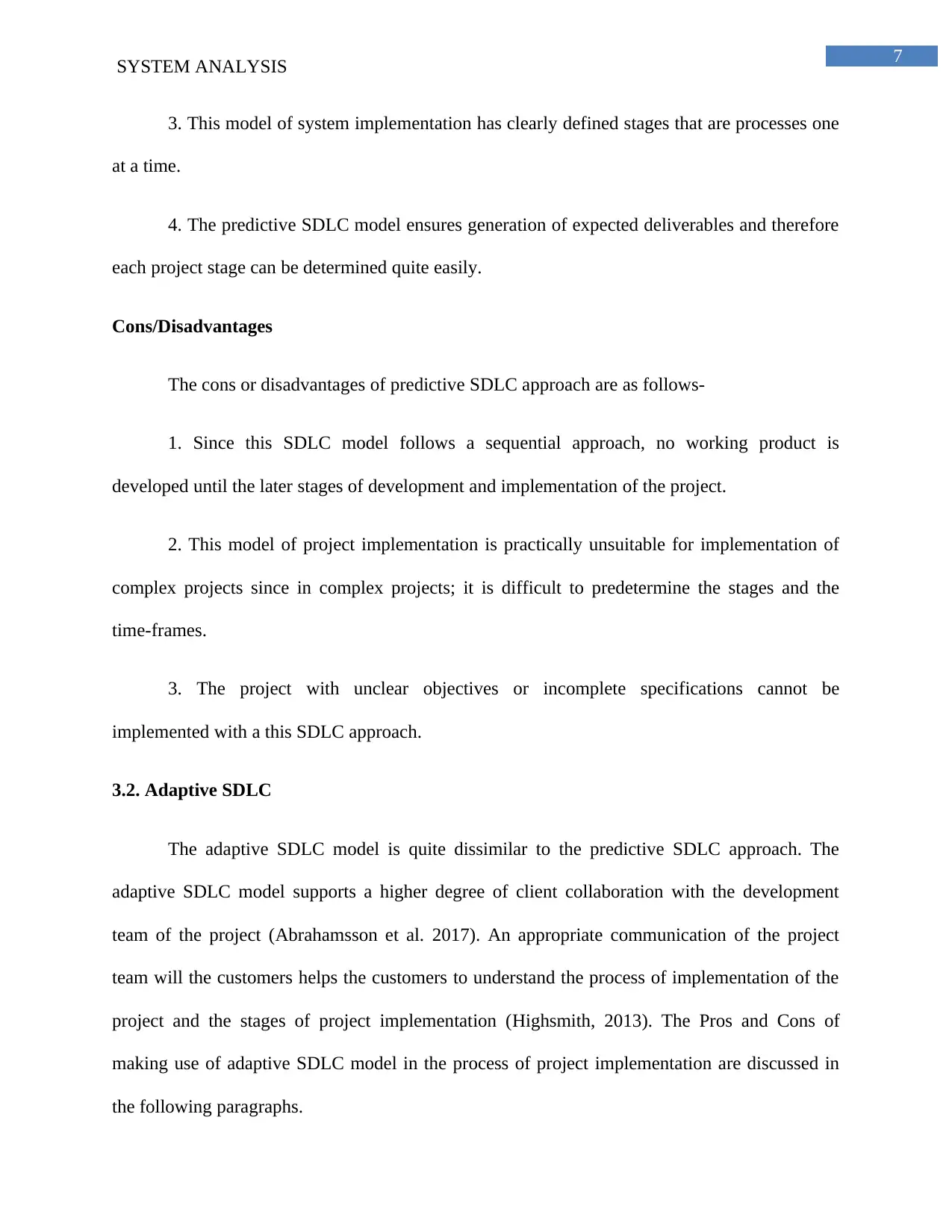
7
SYSTEM ANALYSIS
3. This model of system implementation has clearly defined stages that are processes one
at a time.
4. The predictive SDLC model ensures generation of expected deliverables and therefore
each project stage can be determined quite easily.
Cons/Disadvantages
The cons or disadvantages of predictive SDLC approach are as follows-
1. Since this SDLC model follows a sequential approach, no working product is
developed until the later stages of development and implementation of the project.
2. This model of project implementation is practically unsuitable for implementation of
complex projects since in complex projects; it is difficult to predetermine the stages and the
time-frames.
3. The project with unclear objectives or incomplete specifications cannot be
implemented with a this SDLC approach.
3.2. Adaptive SDLC
The adaptive SDLC model is quite dissimilar to the predictive SDLC approach. The
adaptive SDLC model supports a higher degree of client collaboration with the development
team of the project (Abrahamsson et al. 2017). An appropriate communication of the project
team will the customers helps the customers to understand the process of implementation of the
project and the stages of project implementation (Highsmith, 2013). The Pros and Cons of
making use of adaptive SDLC model in the process of project implementation are discussed in
the following paragraphs.
SYSTEM ANALYSIS
3. This model of system implementation has clearly defined stages that are processes one
at a time.
4. The predictive SDLC model ensures generation of expected deliverables and therefore
each project stage can be determined quite easily.
Cons/Disadvantages
The cons or disadvantages of predictive SDLC approach are as follows-
1. Since this SDLC model follows a sequential approach, no working product is
developed until the later stages of development and implementation of the project.
2. This model of project implementation is practically unsuitable for implementation of
complex projects since in complex projects; it is difficult to predetermine the stages and the
time-frames.
3. The project with unclear objectives or incomplete specifications cannot be
implemented with a this SDLC approach.
3.2. Adaptive SDLC
The adaptive SDLC model is quite dissimilar to the predictive SDLC approach. The
adaptive SDLC model supports a higher degree of client collaboration with the development
team of the project (Abrahamsson et al. 2017). An appropriate communication of the project
team will the customers helps the customers to understand the process of implementation of the
project and the stages of project implementation (Highsmith, 2013). The Pros and Cons of
making use of adaptive SDLC model in the process of project implementation are discussed in
the following paragraphs.
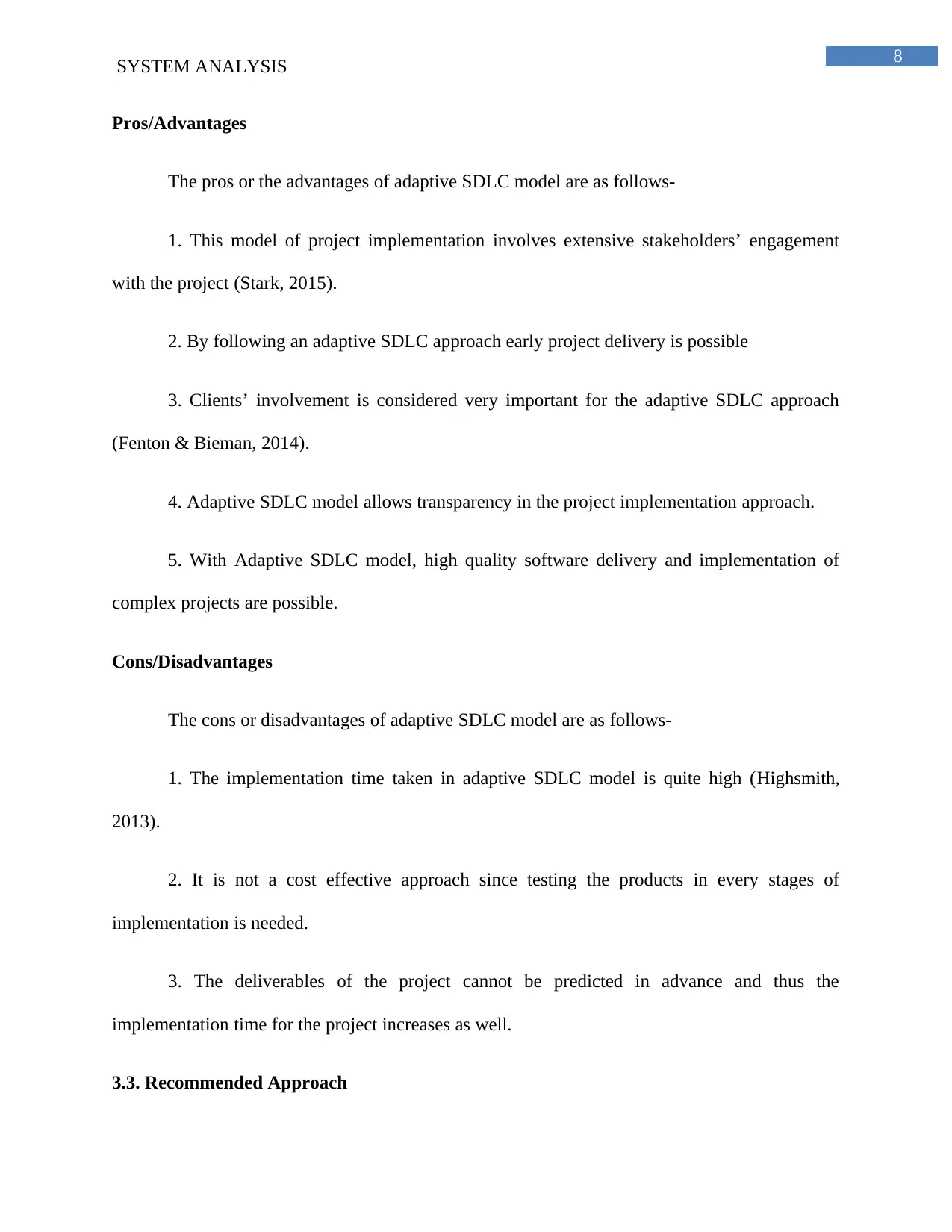
8
SYSTEM ANALYSIS
Pros/Advantages
The pros or the advantages of adaptive SDLC model are as follows-
1. This model of project implementation involves extensive stakeholders’ engagement
with the project (Stark, 2015).
2. By following an adaptive SDLC approach early project delivery is possible
3. Clients’ involvement is considered very important for the adaptive SDLC approach
(Fenton & Bieman, 2014).
4. Adaptive SDLC model allows transparency in the project implementation approach.
5. With Adaptive SDLC model, high quality software delivery and implementation of
complex projects are possible.
Cons/Disadvantages
The cons or disadvantages of adaptive SDLC model are as follows-
1. The implementation time taken in adaptive SDLC model is quite high (Highsmith,
2013).
2. It is not a cost effective approach since testing the products in every stages of
implementation is needed.
3. The deliverables of the project cannot be predicted in advance and thus the
implementation time for the project increases as well.
3.3. Recommended Approach
SYSTEM ANALYSIS
Pros/Advantages
The pros or the advantages of adaptive SDLC model are as follows-
1. This model of project implementation involves extensive stakeholders’ engagement
with the project (Stark, 2015).
2. By following an adaptive SDLC approach early project delivery is possible
3. Clients’ involvement is considered very important for the adaptive SDLC approach
(Fenton & Bieman, 2014).
4. Adaptive SDLC model allows transparency in the project implementation approach.
5. With Adaptive SDLC model, high quality software delivery and implementation of
complex projects are possible.
Cons/Disadvantages
The cons or disadvantages of adaptive SDLC model are as follows-
1. The implementation time taken in adaptive SDLC model is quite high (Highsmith,
2013).
2. It is not a cost effective approach since testing the products in every stages of
implementation is needed.
3. The deliverables of the project cannot be predicted in advance and thus the
implementation time for the project increases as well.
3.3. Recommended Approach
⊘ This is a preview!⊘
Do you want full access?
Subscribe today to unlock all pages.

Trusted by 1+ million students worldwide
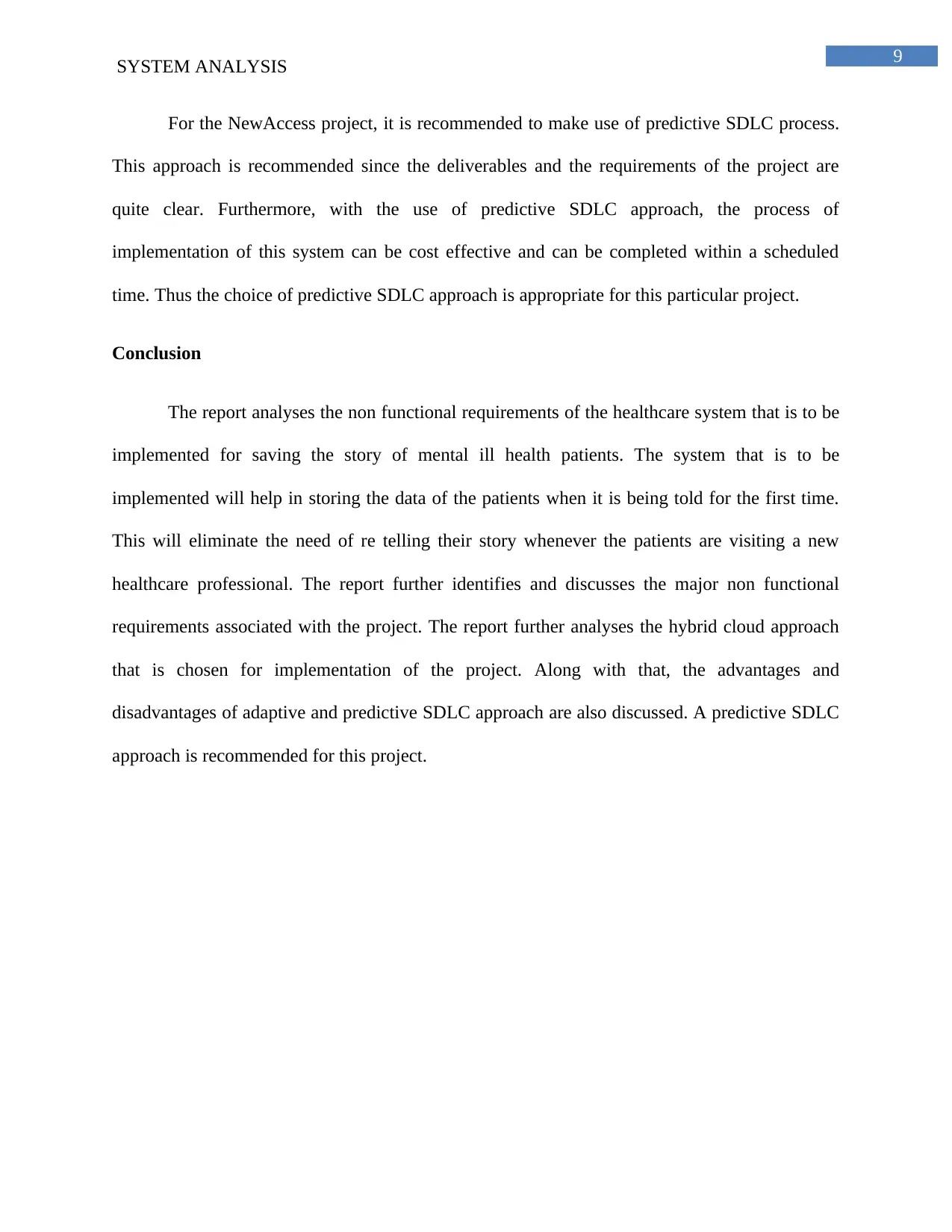
9
SYSTEM ANALYSIS
For the NewAccess project, it is recommended to make use of predictive SDLC process.
This approach is recommended since the deliverables and the requirements of the project are
quite clear. Furthermore, with the use of predictive SDLC approach, the process of
implementation of this system can be cost effective and can be completed within a scheduled
time. Thus the choice of predictive SDLC approach is appropriate for this particular project.
Conclusion
The report analyses the non functional requirements of the healthcare system that is to be
implemented for saving the story of mental ill health patients. The system that is to be
implemented will help in storing the data of the patients when it is being told for the first time.
This will eliminate the need of re telling their story whenever the patients are visiting a new
healthcare professional. The report further identifies and discusses the major non functional
requirements associated with the project. The report further analyses the hybrid cloud approach
that is chosen for implementation of the project. Along with that, the advantages and
disadvantages of adaptive and predictive SDLC approach are also discussed. A predictive SDLC
approach is recommended for this project.
SYSTEM ANALYSIS
For the NewAccess project, it is recommended to make use of predictive SDLC process.
This approach is recommended since the deliverables and the requirements of the project are
quite clear. Furthermore, with the use of predictive SDLC approach, the process of
implementation of this system can be cost effective and can be completed within a scheduled
time. Thus the choice of predictive SDLC approach is appropriate for this particular project.
Conclusion
The report analyses the non functional requirements of the healthcare system that is to be
implemented for saving the story of mental ill health patients. The system that is to be
implemented will help in storing the data of the patients when it is being told for the first time.
This will eliminate the need of re telling their story whenever the patients are visiting a new
healthcare professional. The report further identifies and discusses the major non functional
requirements associated with the project. The report further analyses the hybrid cloud approach
that is chosen for implementation of the project. Along with that, the advantages and
disadvantages of adaptive and predictive SDLC approach are also discussed. A predictive SDLC
approach is recommended for this project.
Paraphrase This Document
Need a fresh take? Get an instant paraphrase of this document with our AI Paraphraser
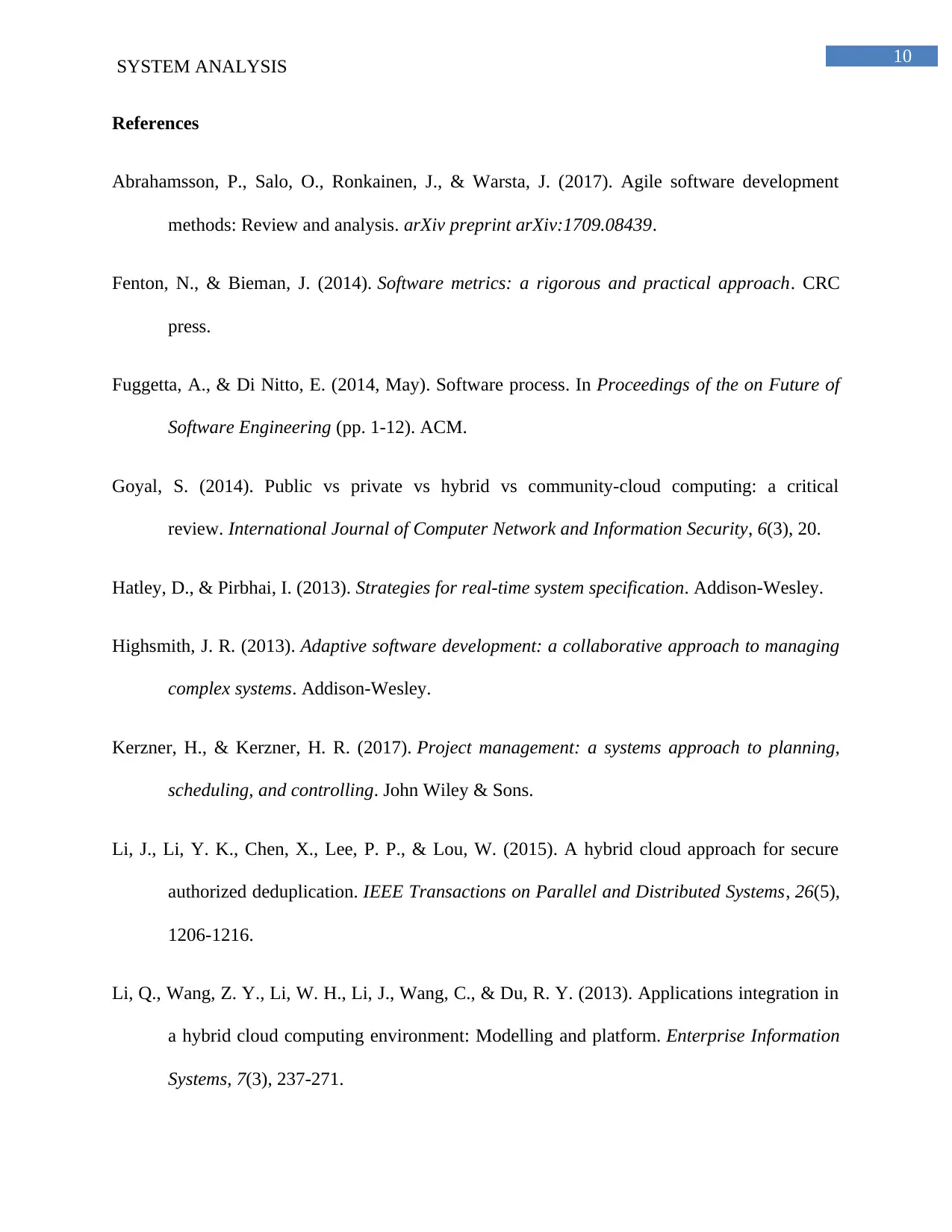
10
SYSTEM ANALYSIS
References
Abrahamsson, P., Salo, O., Ronkainen, J., & Warsta, J. (2017). Agile software development
methods: Review and analysis. arXiv preprint arXiv:1709.08439.
Fenton, N., & Bieman, J. (2014). Software metrics: a rigorous and practical approach. CRC
press.
Fuggetta, A., & Di Nitto, E. (2014, May). Software process. In Proceedings of the on Future of
Software Engineering (pp. 1-12). ACM.
Goyal, S. (2014). Public vs private vs hybrid vs community-cloud computing: a critical
review. International Journal of Computer Network and Information Security, 6(3), 20.
Hatley, D., & Pirbhai, I. (2013). Strategies for real-time system specification. Addison-Wesley.
Highsmith, J. R. (2013). Adaptive software development: a collaborative approach to managing
complex systems. Addison-Wesley.
Kerzner, H., & Kerzner, H. R. (2017). Project management: a systems approach to planning,
scheduling, and controlling. John Wiley & Sons.
Li, J., Li, Y. K., Chen, X., Lee, P. P., & Lou, W. (2015). A hybrid cloud approach for secure
authorized deduplication. IEEE Transactions on Parallel and Distributed Systems, 26(5),
1206-1216.
Li, Q., Wang, Z. Y., Li, W. H., Li, J., Wang, C., & Du, R. Y. (2013). Applications integration in
a hybrid cloud computing environment: Modelling and platform. Enterprise Information
Systems, 7(3), 237-271.
SYSTEM ANALYSIS
References
Abrahamsson, P., Salo, O., Ronkainen, J., & Warsta, J. (2017). Agile software development
methods: Review and analysis. arXiv preprint arXiv:1709.08439.
Fenton, N., & Bieman, J. (2014). Software metrics: a rigorous and practical approach. CRC
press.
Fuggetta, A., & Di Nitto, E. (2014, May). Software process. In Proceedings of the on Future of
Software Engineering (pp. 1-12). ACM.
Goyal, S. (2014). Public vs private vs hybrid vs community-cloud computing: a critical
review. International Journal of Computer Network and Information Security, 6(3), 20.
Hatley, D., & Pirbhai, I. (2013). Strategies for real-time system specification. Addison-Wesley.
Highsmith, J. R. (2013). Adaptive software development: a collaborative approach to managing
complex systems. Addison-Wesley.
Kerzner, H., & Kerzner, H. R. (2017). Project management: a systems approach to planning,
scheduling, and controlling. John Wiley & Sons.
Li, J., Li, Y. K., Chen, X., Lee, P. P., & Lou, W. (2015). A hybrid cloud approach for secure
authorized deduplication. IEEE Transactions on Parallel and Distributed Systems, 26(5),
1206-1216.
Li, Q., Wang, Z. Y., Li, W. H., Li, J., Wang, C., & Du, R. Y. (2013). Applications integration in
a hybrid cloud computing environment: Modelling and platform. Enterprise Information
Systems, 7(3), 237-271.
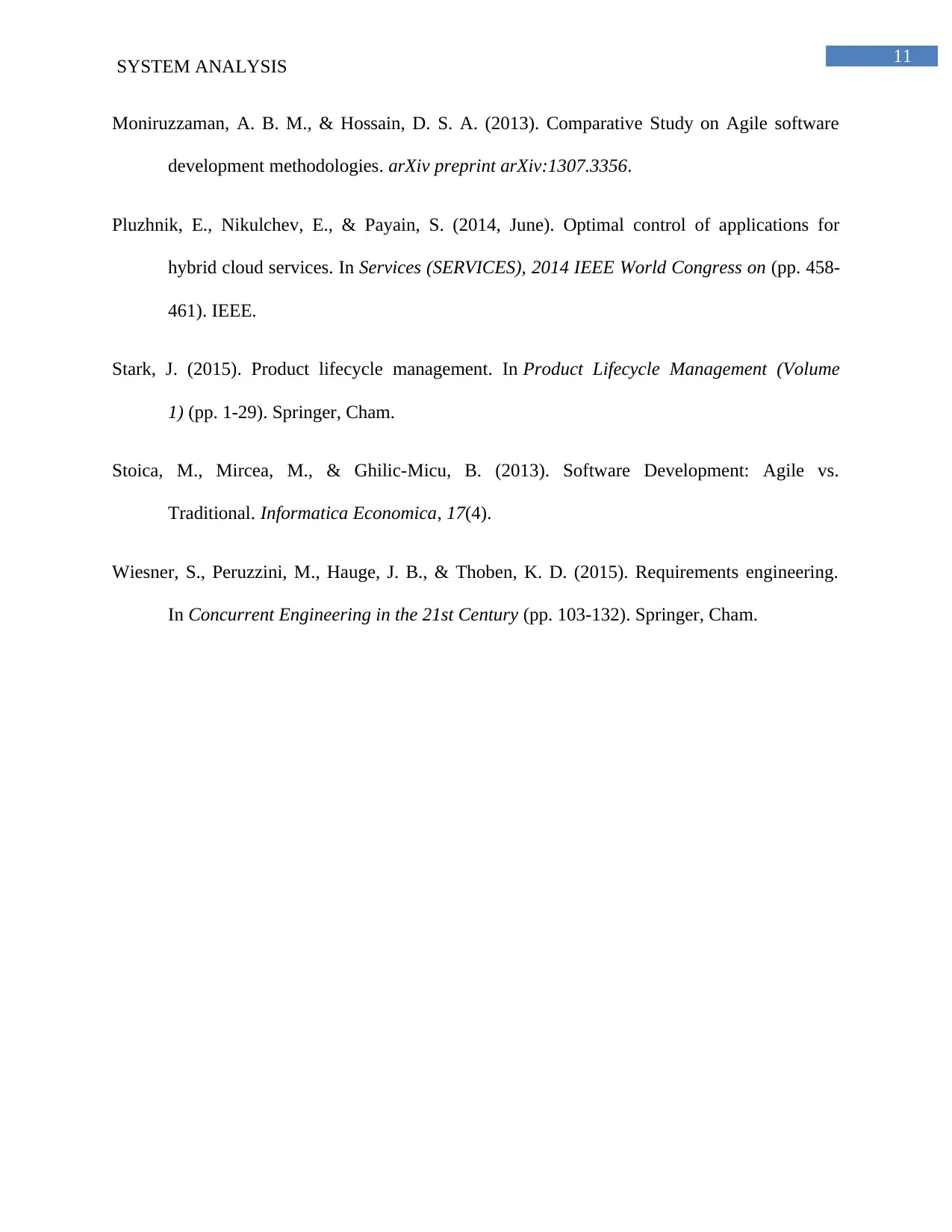
11
SYSTEM ANALYSIS
Moniruzzaman, A. B. M., & Hossain, D. S. A. (2013). Comparative Study on Agile software
development methodologies. arXiv preprint arXiv:1307.3356.
Pluzhnik, E., Nikulchev, E., & Payain, S. (2014, June). Optimal control of applications for
hybrid cloud services. In Services (SERVICES), 2014 IEEE World Congress on (pp. 458-
461). IEEE.
Stark, J. (2015). Product lifecycle management. In Product Lifecycle Management (Volume
1) (pp. 1-29). Springer, Cham.
Stoica, M., Mircea, M., & Ghilic-Micu, B. (2013). Software Development: Agile vs.
Traditional. Informatica Economica, 17(4).
Wiesner, S., Peruzzini, M., Hauge, J. B., & Thoben, K. D. (2015). Requirements engineering.
In Concurrent Engineering in the 21st Century (pp. 103-132). Springer, Cham.
SYSTEM ANALYSIS
Moniruzzaman, A. B. M., & Hossain, D. S. A. (2013). Comparative Study on Agile software
development methodologies. arXiv preprint arXiv:1307.3356.
Pluzhnik, E., Nikulchev, E., & Payain, S. (2014, June). Optimal control of applications for
hybrid cloud services. In Services (SERVICES), 2014 IEEE World Congress on (pp. 458-
461). IEEE.
Stark, J. (2015). Product lifecycle management. In Product Lifecycle Management (Volume
1) (pp. 1-29). Springer, Cham.
Stoica, M., Mircea, M., & Ghilic-Micu, B. (2013). Software Development: Agile vs.
Traditional. Informatica Economica, 17(4).
Wiesner, S., Peruzzini, M., Hauge, J. B., & Thoben, K. D. (2015). Requirements engineering.
In Concurrent Engineering in the 21st Century (pp. 103-132). Springer, Cham.
⊘ This is a preview!⊘
Do you want full access?
Subscribe today to unlock all pages.

Trusted by 1+ million students worldwide
1 out of 12
Related Documents
Your All-in-One AI-Powered Toolkit for Academic Success.
+13062052269
info@desklib.com
Available 24*7 on WhatsApp / Email
![[object Object]](/_next/static/media/star-bottom.7253800d.svg)
Unlock your academic potential
Copyright © 2020–2025 A2Z Services. All Rights Reserved. Developed and managed by ZUCOL.





